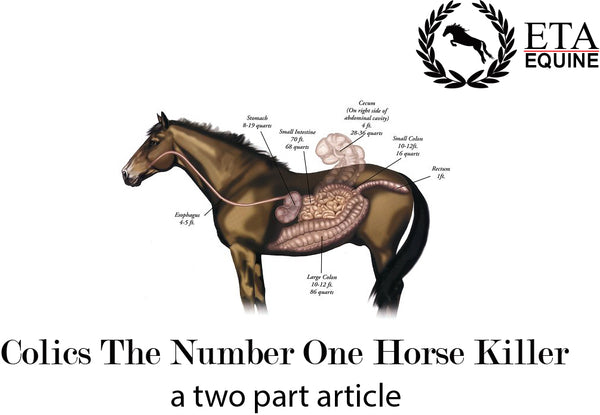Colics The Number One Horse Killer – part 1

What is a colic?
A Colic can be defined as any abdominal pain and by itself is not a diagnosis but a sign that something is causing abdominal pain to a horse. It encompasses all forms of gastrointestinal conditions which cause pain as well as other causes of abdominal pain not related to the gastrointestinal tract. That said, the most common forms of colics are related to the gastrointestinal tract and most frequently related in some way to a colonic disturbance.
Colics are the leading cause of death among domesticated horses, many types of colics require surgical intervention to save a horses life. It is important for those who own horses or work with them to be able to recognize the signs of a colic and determine whether or not a veterinarian should be called to intervene. Colics truly are the number one horse killer.
What causes it?
Colics can be broken down into three main categories; simple obstructions, strangulating obstructions, and non-strangulating infarction. Simple obstructions typically cover all types of impactions such as food impaction. Strangulating obstructions cover all the various forms of entrapments. And finally non-strangulating infarctions cover the various types of infections that can develop and cause abdominal pain.
Treatment
There are different methods of treating colics and some are better suited for certain types of colics. If you suspect your horse to have a colic then the best thing to do is consult with your veterinarian. They will be able to properly diagnose the type of colic and explain to you what method of treatment would be best.
Signs of a colic
Knowing to recognize the signs of a colic are what can give a veterinarian the precious time they need in diagnosing and treating a colic before it becomes lethal for the horse. With that in mind, here are a few signs to help you recognize a horse that may be suffering from a colic:
- Pawing and/or scraping the floor.
- Stretching.
- Frequent attempts to urinate.
- Flank watching (when a horse turns its head to watch their hind quarters or stomach).
- Biting/nipping their stomach.
- Pacing.
- Repeated Flehmen response.
- Repeated laying down and rising.
- Rolling.
- Groaning.
- Bruxism.
- Excess salivation.
- Loss of appetite.
- Decreased fecal output.
- Increased pulse rate.
- Dark mucous membranes.
Prevention
Though the best way of treating a colic is to notify a veterinarian right away, as a rider or horse owner there is much you can do in terms of prevention. The risk of a colic can be reduced by:
- Restricting the access a horse has to simple carbohydrates such as sugar from feeds with excessive molasses.
- Providing clean feed and drinking water.
- Preventing a horse form ingesting sand or dirt by providing an elevated feeding surface.
- Keeping a regular feeding schedule.
- Performing regular de-worming treatments.
- Scheduling regular dental care vet visits.
- Keeping a regular diet that does not change substantially in content or proportion, to avoid upsetting microbes and bacteria in the cecum.
- Putting in place measures to help prevent heat stroke.
- Forcing horses that bolt their feed to eat slower in order to minimize colic danger (as well as choke as was covered in a previous ETA Tips article).
Make sure to like our Facebook page at https://www.facebook.com/ETAEquine to be notified when part 2 of the article comes out on Tuesday March 11th, 2014. In Part 2 we will go into further detail about the different types of colics, their risk, and the best ways to treat them.
X